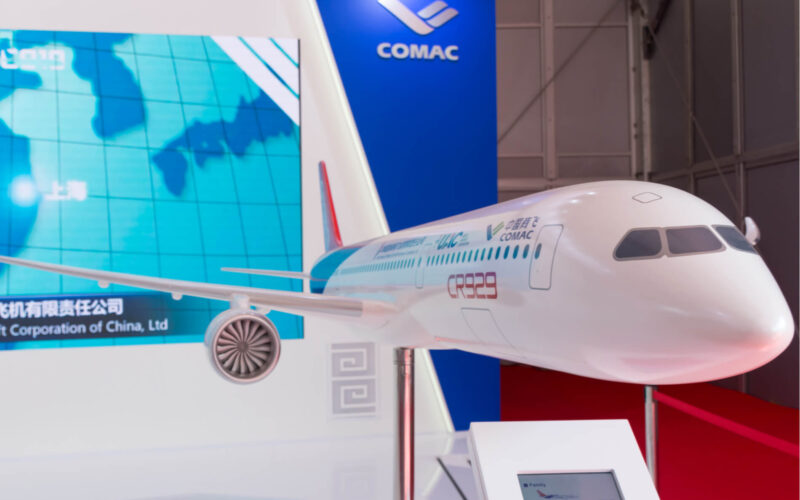The development of Russian-Chinese CRAIC CR929 widebody airliner came unstuck once again, but anxiety remains, resulting in some awkward situations.
On November 16, 2020, an article headlined “MAI transfers composite wing engineering technology to COMAC” appeared in Russian media. According to the text, specialists from Moscow Aviation Institute (MAI), together with their colleagues from Chinese COMAC, started cooperating on the methodology of modelling composite materials into aircraft structures.
The technology transfer itself was not mentioned in the article though. Moreover, it was absent from MAI’s press release, on which the article was based.
The release stated that one of the institute’s subdivisions began a project aimed at testing the structural integrity of composite wings in the event of an explosion of a landing gear tire. Gained knowledge, it said, could be used in the upcoming airplanes with composite wings, such as the CR929.
It also added a few bits of contextual information: that COMAC was one of MAI’s long-running partners and that Chinese colleagues did not have experience in this kind of research.
Both of those facts are true. In 2017, MAI joined United Aircraft Corporation (UAC) and COMAC as a consultant and supervisor, giving advice on composite materials and avionics, thus, at least indirectly participating in the joint attempt to build the CR929, the Russian-Chinese wide-body airliner.
It is also rather apparent that COMAC is unable to manufacture composite wings on its own – the feature is lacking in their newest C919 airliner, putting it behind the main competitors – the Airbus A320neo and the Boeing 737 MAX – in both performance and fuel efficiency.
So, there was a project involving composite materials and the Chinese were there. It is not hard to see how a combination of those facts led to the sensationalist headline, implying that China is about to receive secret Russian technology. Why exactly that headline appeared is a bit more complicated matter.
Bumpy partnership
The idea of the CR929 is based on a premise of two countries doing together what neither of them could do separately. Development of a new aircraft – especially advanced enough to compete with the Boeing 787 and the Airbus A350 – requires incredible investment. China lacked experience and expertise, Russia lacked capabilities and market size.
Those two motivations came head-to-head in early 2020, when the development was frozen because of disagreements over responsibilities. COMAC wanted Chinese market entirely to itself, while Russia desired at least a part of it too. Russia’s domestic market is way too small and there is little hope for the CR929 on a foreign one; therefore, without taping into sales to Chinese airlines, UAC would lose a lot of money. China, of course, was not happy with the possibility of designing an aircraft and then having to buy it from Russia.
There was another issue too, the one of technology transfer. Giving China what it lacks means having another competitor on the map, a foe UAC will almost definitely have to face in the future. Having to compete with Airbus and Boeing is hard enough; if COMAC started manufacturing cheap, available, yet efficient aircraft – say, the C919 upgraded with composite wings – there would be almost no place left for Russian airliners.
There is a patriotic angle as well. As many Russians see it, only shards of once-great Soviet airplane manufacturing remain. Selling out to China means giving up not only technology but pride too. In collaboration on the CR929, Russia would gain one domestically manufactured airplane but give up whatever remains of the former glory.
These sentiments reigned for a while before reaching the peak in mid-2020. On November 3, 2020, Russian Minister of Industry and Trade Denis Manturov and Chinese Minister of Industry and Information Technology Xiao Yaqing had a meeting dedicated to the CR929, agreeing to get rid of all related problems and resume the development of the aircraft. It was not announced how exactly the differences were going to be solved but there definitely was a political will to solve them.
Yet the underlying reasons remain and anxieties fume. The misleading headline, talking of the supposed technology transfer, is a prime example of that. It attracted a lot of attention, and heated discussions in social media followed.
Many noticed that there was little substance behind the claim and the headline was changed to something decidedly less spicy the next day. MAI, accused of selling out, scrubbed their press release of every mention of China and COMAC, and issued a statement denying that any technology transfer occurred. According to them, only materials with theoretical properties were used in calculations and no secret information was revealed to partners.
The story shows that in their cooperation Russia and China have a lot of issues to resolve.

